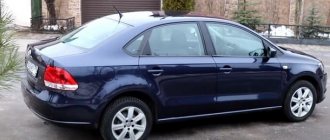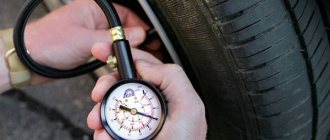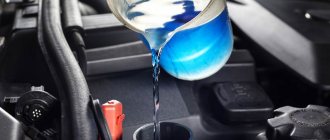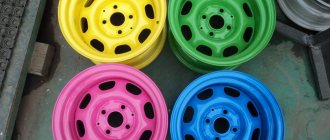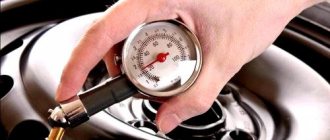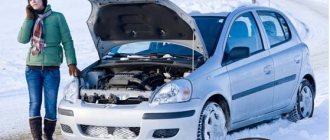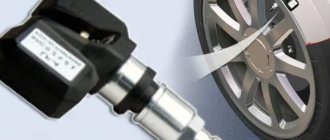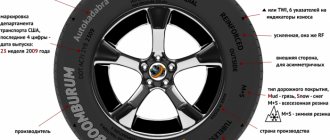Is the pressure in a car’s tires important, how to control it, how much to pump? Some car owners measure pressure by kicking the tire, while others resort to more careful measurements - with a pressure gauge.
Optimal pressure in the tires of a car will allow the driver to fully experience the safety and comfort of driving, while incorrect pressure will cause a lot of trouble.
How is tire pressure measured?
In our country and a number of others, pressure is usually measured in BARs (atmospheres). 1 atm.=1 kgf/cm2. To be extremely precise, 1 atmosphere is equal to 1.0133 bar, but such precision is not needed, it will be concealed by the readings of the pressure gauge, the error of which can reach 2%.
The standard that is common in the USA is PSI (pounds per square inch). To convert PSI to the atmospheres we are familiar with, this value must be divided by 14.5.
Below is a table of approximate ratios of values.
| Pressure Standards | |
| BAR | PSI |
| 1.8 | 26 |
| 1.9 | 28 |
| 2.0 | 29 |
| 2.1 | 30 |
| 2.2 | 32 |
| 2.3 | 33 |
| 2.4 | 35 |
| 2.5 | 36 |
| 2.6 | 38 |
| 2.7 | 39 |
| 2.8 | 41 |
| 2.9 | 42 |
| 3.0 | 44 |
What instruments are used to measure
To check pressure, as a rule, a special device is used - a pressure gauge.
This device can be of three types:
- switch (works with a special spring);
- mechanical (based on a cylindrical spring);
- electronic - a modern device with a liquid crystal screen.
The most popular of this “trinity” is the first dial pressure gauge. It's easy to explain.
The main advantages of this device are reliability, unpretentiousness, and affordable price.
Disadvantages - high risk of failure in case of mechanical impact. A sharp blow can cause the spring to break, and then no measurements can be taken.
The second type of device is more effective - a mechanical pressure gauge. It is made in the form of a special “handle”.
The device is based on a special spring having a cylindrical shape. The main disadvantage of the device is the presence of small errors during measurement.
An electronic pressure gauge has the greatest accuracy. Manufacturers claim that the device is capable of reflecting information with an error of no more than 0.05 Bar (Atmospheres).
But here, too, not everything is clear. Some electronic products (primarily from China) cannot boast such high accuracy. So, pointer instruments are best suited for everyday use.
When the tire is poorly inflated
If the tire is insufficiently inflated, the pressure of the wheel on the road is uneven, the quality (spot) of adhesion to the road surface decreases, and the tire itself is subject to premature wear. In addition, due to low rolling, fuel consumption increases.
Low tire pressure can be easily determined by its deformation, poor handling, and the car will pull towards the flat tire. In this case, there is a high probability of the frame breaking, damage to the cord threads, which will cause the tire to become unusable. To put it in the language of motorists, it will chew rubber.
Pre-selection
If you inflate cold tires, that is, the temperature of the wheel is equal to the ambient temperature, then follow the manufacturer's standards.
In the case when pumping is carried out in a warm garage, the temperature in which exceeds the outside temperature by five degrees Celsius, then the rate must be raised by 0.2 bar. This trick will allow you to compensate for the temperature difference and pump up the optimal pressure for the tires.
At the same time, you should not think that high-quality tire inflation on winter roads will provide better vehicle stability. This is wrong.
Handling is largely influenced by the tread pattern and the quality of the rubber.
If the wheel is overinflated
An overinflated tire becomes too hard. It rolls easily, but like a flat tire, it has insufficient grip on the road, and this is fraught with accidents. The car will jump excessively, increasing the load on the body and suspension elements, and if it gets into a hole, the tire may simply burst.
When the machine is heavily loaded, it is not recommended to greatly increase the tire pressure, since all of the above risks can only intensify.
When you need to lower your tires a little
In some cases, there are recommendations to slightly lower the tire pressure than specified in the recommendations. There are two such cases:
- In winter, if the pressure is a little less, then better traction occurs. But as the temperature changes, the internal volume in the tire also changes.
- The most popular use for slightly lowered wheels is off-road driving. In this case, the wheels will act on the principle of tracks. Which will increase cross-country ability.
But it is difficult for an inexperienced driver to determine by what indicators to reduce the pressure. Therefore, we do not recommend experimenting.
Conclusion: the pressure in car tires must be checked regularly, maintained at the level recommended by the manufacturer, and weather and road conditions taken into account. This will extend their life and help make your ride safer.
What should the pressure be?
The recommended tire pressure is usually determined by the vehicle manufacturer. There are a number of other factors, such as:
- vehicle's own weight;
- disc diameters;
- tire indices and markings.
You can find out what tire pressure should be in your tires from signs placed on the door pillar, gas filler flap or glove compartment. It is recommended to take measurements only when the tire is cold, since as it moves it heats up and the air inside expands, which gives a serious error in measurements.
For greater clarity, below is a table of tire pressures by car brand.
The specified values are recommended by car manufacturers.
New technologies
Run Flat
One of the advanced developments of the tire giants is Run Flat technology, which, thanks to the reinforced sidewall, allows you to ride on tires without pressure and evenly distributes the contact patch and tread along the road.
Tire pressure sensors
Many passenger cars are equipped from the factory with tire pressure sensors, which automatically monitor wheel parameters and notify via the on-board computer of deviations from the recommended parameters. The signal is transmitted at a frequency of 433 MHz, and the sensors contain 3V batteries, which need to be changed periodically.
In addition, the Chinese website Aliexpress offers a cheap solution to the problem of monitoring tire pressure - mechanical sensors instead of caps on the nipple.
Airless tires
Another wonderful invention is tires that do not need to be inflated. The inner part of this slope is reinforced with a row of elastic honeycombs. This design allows you not to worry about tread punctures. Moreover, there is no need to set pressure in them, because the wheel already holds its shape. Such tires have already been produced for trucks, and for passenger cars they will appear in the near future thanks to the work of Michelin, Hankook, Bridgestone and other industry giants.
Source abc-tyre.ru
I usually pump 2.2-2.3 in all 4 wheels
Table
| car brand | Dimensions | Pressure (front/rear) |
| vaz/lada | ||
| 2104 | 165/80 R13 | 1.6/2.1 |
| 175/70 R13 | 1.6/2.2 | |
| 2106 | 165/80 R13 | 1.6/1.9 |
| 175/70 R13 | 1.7/2.0 | |
| 165/70 R13 | 1.8/2.1 | |
| 2107 | 165/80 R13 | 1.6/1.9 |
| 175/70 R13 | 1.7/2.0 | |
| 2109/21099 | 165/70 R13 | 1.9/1.9 |
| 175/70 R13 | 1.9/1.9 | |
| 155/80 R13 | 1.9/1.9 | |
| 2110/2111/2112 | 175/70 R13 | 1.9/1.9 |
| 175/65 R14 | 1.8/1.8 | |
| 185/60 R14 | 1.8/1.8 | |
| 2114/2115 | 165/70 R13 | 1.9/1.9 |
| 175/70 R13 | 1.9/1.9 | |
| vesta | 185/65 R15 | 2.1/2.1 |
| 195/55 R16 | 2.1/2.1 | |
| granta | 175/70 R13 | 1.9/2.1 |
| 175/65 R14 | 2.0/2.2 | |
| Granta liftback | 175/65 R14 | 2.0/2.2 |
| 185/60 R14 | 2.0/2.2 | |
| 185/55 R15 | 2.0/2.2 | |
| viburnum (kalina) | 175/70 R13 | 1.9/1.9 |
| Kalina station wagon/hatchback | 185/60 R14 | 1.9/1.9 |
| priora | 175/70 R13 | 1.9/1.9 |
| 185/60 R14 | 1.9/1.9 | |
| Largus/Largus cross | 185/70 R14 | 2.4/2.6 |
| 185/65 R15 | 2.4/2.6 | |
| Niva | ||
| 2121/21213/21214/2131 | 175/80 R16 | 2.1/1.9 |
| 185/75 R16 | 2.1/2.0 | |
| gas | ||
| 3110/31105 | 195/65 R15 | 2.0/2.1 |
| 3307/3309 | 8.25R20 | 4.5/6.3 |
| 3308 | 12.00R18 | 3.5/4.5 |
| 53 | 8.25R20 | 4.0/6.3 |
| 66 | 8.00R18 | 2.8/2.8 |
| gazelle | ||
| 2705 (business) | 185/75 R16 | 3.0/3.0 |
| 3302 (cargo) | 185/75 R16 | 3.0/3.0 |
| next | 185/75 R16 | 3.6/2.9 |
| passenger | 185/75 R16 | 3.0/3.0 |
| sable | 215/65 R16 | 2.7/2.7 |
| sable 2752 | 185/75 R16 | 3.3/3.9 |
| Valdai | 215/75 R17 | 5.4/6.3 |
| lawn next | 185/75 R16 | 3.3/3.9 |
| zil | ||
| 130/131 | 9.00R20 | 4.5/6.0 |
| 5301 (bull) | 225/75 R16 | 5.0/6.0 |
| UAZ | ||
| 469 | 235/70R16 | 2.0/2.3 |
| patriot | 225/75R16 | 2.0/2.4 |
| 235/70R16 | 1.9/2.2 | |
| 245/70R16 | 1.8/2.1 | |
| 245/60R18 | 1.8/2.0 | |
| loaf | 225/75R16 | 2.0/2.3 |
| hunter | 225/75R16 | 2.0/2.3 |
| 235/70R16 | 2.1/2.4 | |
| KAMAZ | ||
| 4308 | 245/70R19.5 | 4.8/4.8 |
| 4310 | 245/70R19.5 | 4.8/4.8 |
| 43118 | 425/85R21 | 5.6/5.6 |
| other | ||
| maz | 235/75R17.5 | 6.5/7.3 |
| oka | 135/80R12 | 1.8/1.8 |
| Ural 4320 | 390/95R20 | 4.0/4.0 |
| groove 32053 | 245/70R19.5 | 5.6/4.6 |
| audi | ||
| a4 | 225/50R17 | 2.3/2.3 |
| 235/40R18 | 2.5/2.5 | |
| 245/45R17 | 2.2/2.1 | |
| q5 | 235/65R17 | 2.1/2.1 |
| 235/60R18 | 2.1/2.1 | |
| 235/55R19 | 2.1/2.1 | |
| 255/45R20 | 2.1/2.1 | |
| bmw | ||
| x5 | 235/65R17 | 2.2/2.2 |
| 255/55R18 | 2.2/2.2 | |
| 255/50R19 | 2.1/2.5 | |
| e39 | 225/60R15 | 2.0/2.2 |
| 205/65R15 | 2.2/2.4 | |
| 235/40R18 | 1.9/2.3 | |
| 265/35R18 | 2.3/2.7 | |
| 225/55R16 | 2.3/2.7 | |
| 235/45R17 | 2.5/2.7 | |
| x1 | 225/50R17 | 2.2/2.7 |
| 225/45R18 | 2.5/2.7 | |
| daewoo | ||
| matiz | 145/70R13 | 1.9/1.9 |
| 155/65R13 | 1.9/1.9 | |
| nexia | 175/70R13 | 2.0/2.1 |
| 185/60R14 | 2.2/2.4 | |
| dodge | ||
| caliber | 215/60R17 | 2.2/2.2 |
| 215/55R18 | 2.2/2.2 | |
| 225/45R19 | 2.2/2.2 | |
| caravan | 215/65R15 | 2.2/2.3 |
| ford | ||
| focus 3 | 195/65R15 | 2.1/2.1 |
| 205/55R16 | 2.1/2.1 | |
| 205/50R17 | 2.1/2.1 | |
| 225/40R18 | 2.1/2.1 | |
| kuga | 235/55R17 | 2.4/2.4 |
| 235/50R18 | 2.3/2.3 | |
| 235/45R19 | 2.3/2.3 | |
| mondeo 4 | 185/65R14 | 2.1/2.1 |
| 195/60R14 | 2.1/2.1 | |
| 205/55R15 | 2.1/2.1 | |
| transit | 195/70R15 | 3.4/2.7 |
| 195/65R16 | 3.7/4.0 | |
| 205/75R16 | 3.0/3.9 | |
| 215/75R16 | 3.0/4.0 | |
| focus 1 | 185/65R14 | 2.2/2.2 |
| 195/55R15 | 2.0/2.0 | |
| 205/50R16 | 2.2/2.2 | |
| 185/60R15 | 2.2/2.2 | |
| 215/40R17 | 2.2/2.2 | |
| focus 2 | 195/65R15 | 2.1/2.1 |
| 205/55R16 | 2.1/2.1 | |
| 225/40R18 | 2.1/2.1 | |
| fusion | 195/60R15 | 2.4/2.2 |
| 195/55R16 | 2.4/2.2 | |
| Explorer 5 | 235/75R15 | 2.1/2.4 |
| 225/70R15 | 2.1/2.4 | |
| fiat (fiat) | ||
| ducato | 195/70R15 | 4.1/4.5 |
| 205/70R15 | 4.1/4.5 | |
| 215/75R16 | 4.5/4.5 | |
| Jeep (jeep) | ||
| Grand Cherokee | 225/75R16 | 2.3/2.3 |
| 235/65R17 | 2.3/2.3 | |
| 235/70R16 | 2.3/2.3 | |
| 245/60R18 | 2.3/2.3 | |
| Hyundai | ||
| 78 | 175/60R14 | 2.3/2.3 |
| 175/50R15 | 2.3/2.3 | |
| ix35 | 215/70R16 | 2.3/2.3 |
| 225/60R17 | 2.3/2.3 | |
| accent | 155/80R13 | 2.1/2.1 |
| 185/60R14 | 2.1/2.1 | |
| 175/70R14 | 2.1/2.1 | |
| 195/55R15 | 2.1/2.1 | |
| Creta (Greta) | 215/65R16 | 2.3/2.3 |
| porter 2 (portrer) | 185/80R14 | 3.0/4.5 |
| solaris | 185/65R15 | 2.2/2.2 |
| 195/55R16 | 2.2/2.2 | |
| tucson | 215/65R16 | 2.1/2.1 |
| 235/60R16 | 2.1/2.1 | |
| getz | 155/80R13 | 2.1/2.1 |
| 175/65R14 | 2.1/2.1 | |
| 185/55R15 | 2.1/2.1 | |
| santa fe | 215/70R15 | 2.1/2.1 |
| 225/70R16 | 2.1/2.1 | |
| 235/70R16 | 2.1/2.1 | |
| 235/60R18 | 2.1/2.1 | |
| Chery | ||
| Cherie Tiggo (tiggo) | 225/65R17 | 2.3/2.3 |
| Chevrolet | ||
| aveo | 155/80R13 | 2.1/2.1 |
| 185/60R14 | 2.1/2.1 | |
| 195/65R15 | 2.5/2.5 | |
| 205/55R16 | 2.5/2.5 | |
| cobalt | 185/75R14 | 2.5/2.5 |
| 195/65R15 | 2.4/2.4 | |
| lanos | 175/70R13 | 2.2/2.2 |
| 185/60R14 | 2.2/2.2 | |
| Lacetti | 195/55R15 | 2.3/2.3 |
| Chevy Niva | 205/65R15 | 2.1/2.1 |
| 205/70R15 | 2.1/2.1 | |
| 215/65R16 | 2.2/2.2 | |
| captiva | 215/70R16 | 2.1/2.1 |
| 235/55R18 | 2.1/2.1 | |
| Cruze | 205/60R16 | 2.2/2.2 |
| 215/55R17 | 2.2/2.2 | |
| Kia | ||
| picanto | 155/70R13 | 2.1/2.1 |
| 165/60R14 | 2.1/2.1 | |
| 175/50R15 | 2.1/2.1 | |
| rio | 155/80R13 | 2.1/2.1 |
| 175/70R13 | 2.1/2.1 | |
| 175/70R14 | 2.1/2.1 | |
| 185/65R15 | 2.1/2.1 | |
| 195/55R15 | 2.2/2.2 | |
| 195/55R16 | 2.2/2.2 | |
| seed | 185/65R15 | 2.2/2.2 |
| 225/45R17 | 2.2/2.2 | |
| sorento | 225/75R16 | 2.5/2.5 |
| 245/70R16 | 2.5/2.5 | |
| 235/65R17 | 2.2/2.2 | |
| 235/60R18 | 2.3/2.3 | |
| sportage (3, 4, 2016) | 205/70R15 | 1.8/1.8 |
| 215/65R16 | 2.1/2.1 | |
| 235/60R16 | 2.1/2.1 | |
| 215/70R16 | 2.3/2.3 | |
| 225/60R17 | 2.3/2.3 | |
| cerato | 195/60R15 | 2.1/2.1 |
| 205/50R16 | 2.1/2.1 | |
| Lexus (Lexus) | ||
| 570 | 285/60R18 | 2.3/2.6 |
| 285/50R20 | 2.3/2.6 | |
| rx350 | 225/60R17 | 2.1/2.1 |
| 235/55R18 | 2.2/2.2 | |
| 235/60R18 | 2.3/2.3 | |
| 235/55R19 | 2.3/2.3 | |
| Mitsubishi (Mitsubishi) | ||
| Lancer 10 (9) | 195/60R15 | 2.2/2.1 |
| 195/50R16 | 2.3/2.1 | |
| 235/45R17 | 2.2/1.9 | |
| 205/60R16 | 2.2/2.2 | |
| 215/45R18 | 2.2/2.2 | |
| Outlander | 215/55R16 | 2.1/2.0 |
| 215/70R16 | 2.2/2.2 | |
| 215/55R17 | 2.2/2.2 | |
| 225/55R18 | 2.2/2.2 | |
| Pajero 4 (pajero) | 265/65R17 | 2.2/2.4 |
| 265/60R18 | 2.2/2.4 | |
| Mercedes (Mercedes) | ||
| sprinter | 225/70R15 | 2.8/4.0 |
| Mazda (Mazda) | ||
| 3 | 195/65R15 | 2.2/2.2 |
| 205/60R15 | 2.5/2.3 | |
| 205/55R16 | 2.2/2.2 | |
| 6 | 195/65R15 | 2.2/2.2 |
| 195/65R16 | 2.2/2.2 | |
| 205/55R16 | 2.2/2.2 | |
| 215/45R17 | 2.2/2.2 | |
| 215/50R17 | 2.2/2.2 | |
| 215/45R18 | 2.2/2.2 | |
| cx 5 | 225/65R17 | 2.3/2.3 |
| 225/55R19 | 2.5/2.5 | |
| cx 7 | 235/60R18 | 2.2/2.2 |
| 235/55R19 | 2.2/2.2 | |
| Nissan | ||
| Qashqai | 215/65R16 | 2.3/2.3 |
| 215/60R17 | 2.3/2.3 | |
| 215/55R18 | 2.3/2.3 | |
| almera/classic | 185/65R15 | 2.0/2.0 |
| 195/60R15 | 2.0/2.0 | |
| 195/55R16 | 2.0/2.0 | |
| laptop (note) | 185/65R15 | 2.3/2.1 |
| 175/65R15 | 2.3/2.1 | |
| 185/55R16 | 2.3/2.1 | |
| teana | 205/65R16 | 2.2/2.0 |
| 215/55R17 | 2.2/2.0 | |
| tiida | 185/65R15 | 2.3/2.1 |
| 195/65R16 | 2.3/2.1 | |
| x trail (x-trail) | 215/70R15 | 2.2/2.2 |
| 215/65R16 | 2.2/2.2 | |
| x trail t31 | 215/65R16 | 2.3/2.1 |
| 225/60R17 | 2.3/2.1 | |
| 225/55R18 | 2.3/2.1 | |
| Opel (Opel) | ||
| astra jh (astra) | 225/55R17 | 2.2/2.2 |
| 235/55R17 | 2.2/2.2 | |
| 235/50R18 | 2.2/2.2 | |
| 245/45R18 | 2.2/2.2 | |
| 235/45R19 | 2.2/2.2 | |
| 245/40R20 | 2.2/2.2 | |
| corsa | 185/70R14 | 2.0/1.8 |
| 185/65R15 | 2.0/1.8 | |
| 195/60R15 | 2.0/1.8 | |
| 195/55R16 | 2.0/1.8 | |
| 215/45R17 | 2.0/1.8 | |
| Peugeot | ||
| 206 | 165/70R13 | 2.2/2.2 |
| 175/65R14 | 2.4/2.4 | |
| 185/55R15 | 2.3/2.3 | |
| 205/45R16 | 2.3/2.3 | |
| 307 | 195/65R15 | 2.3/2.3 |
| 205/55R16 | 2.5/2.5 | |
| 205/50R17 | 2.5/2.5 | |
| 308 | 195/65R15 | 2.3/2.3 |
| 205/55R16 | 2.4/2.4 | |
| 215/55R16 | 2.5/2.5 | |
| 225/45R17 | 2.5/2.5 | |
| 225/40R18 | 2.7/2.7 | |
| boxer | 195/70R15 | 4.1/4.5 |
| 205/70R15 | 4.1/4.5 | |
| 205/75R16 | 4.5/4.7 | |
| 215/75R16 | 4.5/4.7 | |
| 215/70R15 | 4.1/4.1 | |
| 215/70R16 | 5.0/5.0 | |
| 225/75R16 | 4.6/5.1 | |
| partner | 165/70R14 | 2.4/2.6 |
| 175/65R14 | 2.6/2.6 | |
| 185/65R15 | 2.0/2.2 | |
| 195/65R15 | 2.3/2.3 | |
| Renault (Renault) | ||
| sandero | 185/65R15 | 2.2/2.2 |
| 195/55R16 | 2.2/2.2 | |
| simbol | 175/70R13 | 1.9/2.1 |
| 175/65R14 | 1.9/2.1 | |
| 185/60R14 | 2.2/2.4 | |
| 185/55R15 | 2.3/2.5 | |
| duster | 215/65R16 | 2.0/2.0 |
| logan | 165/80R14 | 2.0/2.0 |
| 185/65R15 | 2.1/2.0 | |
| Megane 2 | 195/65R15 | 2.4/2.0 |
| 205/55R16 | 2.2/2.0 | |
| 205/50R17 | 2.2/2.0 | |
| 205/55R17 | 2.2/2.0 | |
| SsangYong | ||
| Kyron | 225/75R16 | 2.3/2.3 |
| 235/75R16 | 2.1/2.1 | |
| 255/60R18 | 2.1/2.1 | |
| Subaru (subaru) | ||
| outback | 185/70R14 | 2.2/2.1 |
| 195/60R15 | 2.2/2.1 | |
| 205/50R16 | 2.3/2.2 | |
| 215/60R16 | 2.0/2.0 | |
| 205/55R16 | 2.2/2.2 | |
| 215/45R17 | 2.2/2.2 | |
| 215/50R17 | 2.5/2.4 | |
| 215/55R17 | 2.2/2.0 | |
| 225/60R17 | 2.3/2.2 | |
| Suzuki | ||
| grand vitara | 195/80R15 | 1.8/1.8 |
| 205/75R15 | 1.8/1.8 | |
| 215/65R16 | 1.8/2.1 | |
| 235/60R16 | 1.8/1.8 | |
| 215/70R15 | 2.2/2.2 | |
| 225/65R17 | 2.2/2.2 | |
| Toyota | ||
| rav4 (rav 4) | 215/70R16 | 2.0/2.0 |
| 235/60R16 | 2.0/2.0 | |
| 225/65R17 | 2.2/2.2 | |
| 235/55R18 | 2.2/2.2 | |
| land cruiser prado | 215/80R16 | 2.2/2.2 |
| land cruiser prado | 265/70R16 | 2.6/2.4 |
| 100, 120, 150, 200 | 225/70R17 | 2.4/2.4 |
| 265/65R17 | 2.4/2.4 | |
| auris | 195/65R15 | 2.2/2.2 |
| 205/55R16 | 2.3/2.3 | |
| 225/45R17 | 2.3/2.3 | |
| camry | 205/65R15 | 2.3/2.3 |
| 215/60R16 | 2.1/2.1 | |
| corolla | 155/80R13 | 2.1/2.0 |
| 165/70R14 | 2.2/2.2 | |
| 175/65R14 | 2.2/2.2 | |
| 185/65R14 | 2.2/2.2 | |
| 185/55R15 | 2.2/2.2 | |
| 195/55R15 | 2.2/2.2 | |
| Volkswagen (volkswagen) | ||
| b5, b6 | 195/65R15 | 1.9/1.9 |
| 205/60R15 | 2.4/2.2 | |
| 205/55R16 | 2.0/1.9 | |
| 225/45R17 | 2.3/2.1 | |
| polo sedan (polo) | 195/55R15 | 2.0/1.9 |
| 205/45R16 | 2.3/2.1 | |
| tiguan | 215/65R16 | 2.2/2.2 |
| 215/60R17 | 2.2/2.2 | |
| 235/55R17 | 2.2/2.2 | |
| 235/50R18 | 2.2/2.2 | |
| Tuareg (Tuareg) | 235/65R17 | 2.3/2.5 |
| 255/60R17 | 2.3/2.5 | |
| 255/55R18 | 2.3/2.5 | |
| 265/50R19 | 2.3/2.5 | |
| 275/45R20 | 2.3/2.5 | |
| 275/40R21 | 2.3/2.5 | |
| Volvo (Volvo) | ||
| xc90 | 235/65R17 | 2.2/2.7 |
| 235/60R18 | 2.7/2.7 | |
| 255/50R19 | 2.4/2.4 | |
| 255/45R20 | 2.4/2.4 | |
| Scoda (Skoda) | ||
| Octavia A5 (octavia) | 195/65R15 | 2.2/2.2 |
| 205/60R15 | 2.1/2.2 | |
| 205/55R16 | 2.2/2.2 | |
| 225/45R17 | 2.2/2.2 | |
| Octavia A7 | 195/65R15 | 2.2/2.3 |
| 205/55R16 | 2.1/2.1 | |
| 205/50R17 | 2.1/2.1 | |
| 225/45R17 | 2.1/2.1 | |
| 225/40R18 | 2.0/2.1 | |
| rapid | 185/60R15 | 2.2/2.4 |
| 195/55R15 | 2.2/2.4 | |
| 215/45R16 | 2.2/2.3 | |
| 215/40R17 | 2.2/2.3 | |
| Honda | ||
| CRV | 205/70R15 | 1.8/1.8 |
| 205/65R16 | 1.8/1.8 | |
| 215/65R16 | 2.1/2.0 | |
Winter tire pressure
The optimal pressure in car tires in winter and summer may differ slightly. In winter, wheels can be inflated 0.2-0.3 atmospheres more than in summer. This is due to the fact that when the air heats up, the pressure inside the wheel increases, and when it cools, it decreases. This means that an equal volume of air in winter and summer will have different values.
| Size | In summer | in winter |
| R13 | 1.9 | 2.1 |
| R14 | 2.0 | 2.2 |
| R15 | 2.0 | 2.2 |
| R16 | 2.0 | 2.2 |
| R17 | 2.2 | 2.4 |
Verification period
Car enthusiasts are often interested in how often to check tire pressure.
Here a lot depends on the mileage of the vehicle. In particular, it is recommended to do checks at least twice a week.
This is due to the fact that the structural elements of the tire do not have a perfect seal, so the air will still gradually escape.
All-season tires are also in the “risk zone”, the pressure in which decreases with cold weather.
Therefore, when choosing all-season tires, take into account the need to inflate the products in cold weather.
The ideal option is to check the indicator and pump it up every time you leave the garage, visit a gas station or service station.
The check should be carried out early in the morning, while the tires are still warm. If you take measurements while on the road, the indicators will not be accurate.
The check must be carried out on all wheels (including the spare wheel).
There are situations when there is a wheel in the trunk instead of a regular wheel. In such cases, the indicator should be slightly lower than in other wheels.
If you don’t have time to regularly check your tire pressure, then do this work at least before a long trip.
Don’t forget to remind the specialists at the service station so that they set the correct indicator when changing the car’s shoes.
There are car enthusiasts who visually assess the condition of their tires. This approach is irresponsible. It is almost impossible to notice “by eye” a decrease (increase) in tire pressure by 0.1-0.5 atmospheres.
Pressure monitoring using instruments
Most drivers do not want to check their pressure often. The reasons are different: dirty wheels, the “painstaking” procedure - unscrew the cap and measure with a pressure gauge. Indicator caps were invented for such “lazy people”; they display tire pressure.
They are mounted directly on the valve, everything is already set to a pressure of 1.8 - 4 atmospheres. The devices are universal and can be installed on any valves of tubes and tubeless tires of motorcycles, cars, trucks, buses and other vehicles.
The color pressure sensor is installed in place of the standard cap. The condition of the tire is determined by the rod with sectors of different colors. A green mark means everything is normal. The yellow sector will report a pressure drop of 0.3 atmospheres below normal.
At this pressure, movement is permissible at a speed not exceeding 50 km/h. The red sector signal means that the tire pressure has dropped to an unacceptable value - by 0.7 atmospheres or more, this requires immediate tire inflation.
The use of measuring devices is most widespread on cars of the middle and executive classes. They are equipped with light and sound indications and display readings on the monitor, so the driver will immediately know about any changes. We wrote in more detail about such control systems in this article.
Popular tire models
- Yandex.Market rating: Yandex.Market: 4
Goodyear Eagle F1 Asymmetric 3 SUV tiresSeasonality: summer Spikes: no Diameter: / 17 / 18 / 19 / 20 / 21 / 22
More details
- Yandex.Market rating: Yandex.Market: 4.5
Goodyear Eagle Sport TZ tires
Seasonality: summer Spikes: no Diameter: 16 / 17 / 18
More details
- Yandex.Market rating: Yandex.Market: 4
Goodyear EfficientGrip 2 SUV Tires
Seasonality: summer Spikes: no Diameter: 16 / 17 / 18 / 19 / 20 / 21 / 22
More details
- Yandex.Market rating: Yandex.Market: 4.5
Goodyear EfficientGrip Performance Tires
Seasonality: summer Spikes: no Diameter: 15 / 16 / 17 / 18 / 19 / 20
More details
- Goodyear UltraGrip Arctic 2 SUV Tires
Seasonality: winter Spikes: yes Diameter: 17 / 18 / 19 / 20 / 21
More details
- Yandex.Market rating: Yandex.Market: 4.5
Goodyear UltraGrip Ice 2 tires
Seasonality: winter Spikes: no Diameter: 15 / 16 / 17 / 18 / 19
More details
- Yandex.Market rating: Yandex.Market: 4.5
Goodyear UltraGrip Ice SUV Tires
Seasonality: winter Spikes: no Diameter: 16 / 17 / 18 / 19 / 20 / 21
More details
- Yandex.Market rating: Yandex.Market: 5
Goodyear Vector 4Seasons Gen-3 SUV Tires
Seasonality: all-season Spikes: no Diameter: 16 / 17 / 18 / 19 / 20
More details
- Yandex.Market rating: Yandex.Market: 4
Goodyear Wrangler HP All Weather Tires
Seasonality: summer Spikes: no Diameter: 16 / 17 / 18 / 19
More details
- Yandex.Market rating: Yandex.Market: 4.5
Goodyear Vector 4Seasons tires
Seasonality: all-season Spikes: no Diameter: 15 / 16 / 17 / 18
More details
- Yandex.Market rating: Yandex.Market: 4.5
Goodyear Wrangler All-Terrain Adventure tires with Kevlar
Seasonality: summer Spikes: no Diameter: 15 / 16 / 17 / 18 / 20
More details
- Yandex.Market rating: Yandex.Market: 4.5
Goodyear EfficientGrip SUV Tires
Seasonality: summer Spikes: no Diameter: 16 / 17 / 18 / 19 / 20 / 21 / 22
More details
- Yandex.Market rating: Yandex.Market: 4
Goodyear Eagle F1 Asymmetric SUV tires
Seasonality: summer Spikes: no Diameter: 17 / 18 / 19 / 20 / 22
More details
- Goodyear UltraGrip Performance+ SUV Tires
Seasonality: winter Spikes: no Diameter: 16 / 17 / 18 / 19 / 20 / 21
More details
Sealing mixtures and armor
In case of “catching a nail”, there are various mixtures. You just need to pump them into the wheel in advance, after which you can safely drive to the tire shop. Tires have long been invented that can continue moving, even if there is no air in them.
These are the so-called hard side tires. On such tires, if there is a puncture or valve failure, you can drive at speeds of up to 80 km/h. The car maintains maneuverability and stability in turns. These tires are called Run Flat.
Armored limousines are equipped with wheels equipped with special rims and inserts-bandages consisting of high-strength metal or plastic. Even if the car explodes or the tires are deformed, they can travel a very significant distance at a speed of 60-80 km/h. Of course, such wheels are an expensive pleasure.
Why are pressure values different for different axes?
The car must be well balanced. But placing a significant load in a relatively light body cannot be uniform; this is not aviation, and in overloaded wheels the pressure must be increased.
Therefore, in the accompanying documentation or on body plates, they usually indicate either different pressures along the axles, if initially one axle is loaded more, or even two values per axle in versions with or without load.
Let's sum it up
Practice shows that during the operation of any, even the most famous tires, from time to time everyone has to visit a “tire repair shop” to perform inflation.
In order not to be left on the side of the road with a broken or flat tire, you should remember the golden rules:
- The spare wheel must be in good condition, ready to replace a broken one.
- There should be a compressor or pump in the trunk to inflate the tires.
What else is worth reading
Wheel rim bolt pattern
The suspension device, how it works and what it consists of
Car clutch device Clutch as an important element of the transmission
High pressure fuel pump design
How to measure blood pressure: the correct sequence
Alas, even the majority of experienced drivers completely ignore the procedure for monitoring the tire pressure of a car, considering this procedure absolutely useless. Checking tire pressure is carried out using a pressure gauge, which can be integral with the pump, or be a separate element. Do not forget that the error of any pressure gauge is usually 0.2 kgf/cm 2.
Pressure measurement sequence:
- It is necessary to reset the pressure gauge readings.
- Unscrew the safety cap (if equipped) from the wheel nipple.
- Connect the pressure gauge to the nipple and press it lightly to release air from the chamber.
- Wait until the instrument needle stops.
This procedure must be performed monthly during regular use of the vehicle. The measurement should be taken before leaving, when the tires are not yet warmed up. This is necessary to accurately determine the readings, since after the tires warm up, the air pressure inside them increases. This is often caused by dynamic driving with constant changes in speed and sudden braking. For this reason, it is ideal to take measurements before driving, when the tires on the car have not yet warmed up.
